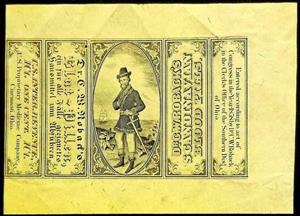Stamp: United States Proprietary Medicine Company (United States of America 1871)
United States Proprietary Medicine Company (United States of America 1871)
01 January (United States of America ) within release Private Die Medicine goes into circulation Stamp United States Proprietary Medicine Company face value 1 United States cent
| Stamp United States Proprietary Medicine Company in catalogues | |
|---|---|
| Stamp Number: | Sn: US RS246b |
Stamp is square format.
RS246b, RS247b and RS248b had a combined print run of 31,625Also in the issue Private Die Medicine:
- Stamp - B. A. Fahnestock face value 1;
- Stamp - B. Brandreth face value 1;
- Stamp - B. Brandreth face value 1;
- Stamp - Curtis & Brown face value 1;
- Stamp - Demas Barnes & Co. face value 1;
- Stamp - Dr. John Bull face value 4;
- Stamp - Frederick Brown Medicine Company face value 2;
- Stamp - John I. Brown & Son face value 4;
- Stamp - Perry Davis & Son face value 2;
- Stamp - Perry Davis & Son face value 2;
- Stamp - Perry Davis & Son face value 4;
- Stamp - A. B. & D. Sands face value 1;
- Stamp - A. L. Scovill & Co. face value 1;
- Stamp - A. L. Scovill & Co. face value 4;
- Stamp - Alvah Littlefield face value 1;
- Stamp - Bennett Pieters & Co. face value 4;
- Stamp - Dr. D. Jayne & Son face value 1;
- Stamp - Dr. D. Jayne & Son face value 4;
- Stamp - Dr. D. Jayne & Son face value 1;
- Stamp - Dr. D. Jayne & Son face value 1;
- Stamp - Dr. D. Jayne & Son face value 2;
- Stamp - Dr. D. Jayne & Son face value 4;
- Stamp - Dr. D. Jayne & Son face value 4;
- Stamp - Edward Wilder face value 1;
- Stamp - Edward Wilder face value 4;
- Stamp - Hall & Ruckel face value 1;
- Stamp - Hall & Ruckel face value 3;
- Stamp - Helmbold's Genuine Preparations face value 6;
- Stamp - Herrick's Pills face value 1;
- Stamp - Hostetter & Smith face value 4;
- Stamp - Hutchings & Hillyer face value 4;
- Stamp - John F. Henry face value 1;
- Stamp - John F. Henry face value 4;
- Stamp - Merchant's Gargling Oil face value 2;
- Stamp - Ring's Vegetable Ambrosia face value 4;
- Stamp - Ring's Vegetable Ambrosia face value 4;
- Stamp - United States Proprietary Medicine Company face value 1;
- Stamp - United States Proprietary Medicine Company face value 1;
- Stamp - United States Proprietary Medicine Company face value 1;
- Stamp - William Swaim face value 8;
- Stamp - William Swaim face value 8;
- Stamp - William Swaim face value 8;
- Stamp - Wright's Indian Vegetable Pills face value 1;
Stamp United States Proprietary Medicine Company it reflects the thematic directions:
A medication (also called medicament, medicine, pharmaceutical drug, medicinal drug or simply drug) is a drug used to diagnose, cure, treat, or prevent disease. Drug therapy (pharmacotherapy) is an important part of the medical field and relies on the science of pharmacology for continual advancement and on pharmacy for appropriate management.
A man is an adult male human. Prior to adulthood, a male human is referred to as a boy (a male child or adolescent).
A modern sailing ship or sailship is any large wind-powered vessel. Traditionally a sailing ship (or simply ship) is a sailing vessel that carries three or more masts with square sails on each. Large sailing vessels that are not ship-rigged may be more precisely referred to by their sail rig, such as schooner, barque (also spelled "bark"), brig, barkentine, brigantine or sloop. There are many different types of sailing ships, but they all have certain basic things in common. Every sailing ship has a hull, rigging and at least one mast to hold up the sails that use the wind to power the ship. The crew who sail a ship are called sailors or hands. They take turns to take the watch, the active managers of the ship and her performance for a period. Watches are traditionally four hours long. Some sailing ships use traditional ship's bells to tell the time and regulate the watch system, with the bell being rung once for every half hour into the watch and rung eight times at watch end (a four-hour watch). Ocean journeys by sailing ship can take many months, and a common hazard is becoming becalmed because of lack of wind, or being blown off course by severe storms or winds that do not allow progress in the desired direction. A severe storm could lead to shipwreck, and the loss of all hands. Sailing ships are limited in their maximum size compared to ships with heat engines, so economies of scale are also limited. The heaviest sailing ships (limited to those vessels for which sails were the primary means of propulsion) never exceeded 14,000 tons displacement. Sailing ships are therefore also very limited in the supply capacity of their holds, so they have to plan long voyages carefully to include many stops to take on provisions and, in the days before watermakers, fresh water.
A ship is a large watercraft that travels the world's oceans and other sufficiently deep waterways, carrying passengers or goods, or in support of specialized missions, such as defense, research and fishing. Historically, a "ship" was a sailing vessel with at least three square-rigged masts and a full bowsprit. Ships are generally distinguished from boats, based on size, shape and load capacity.




